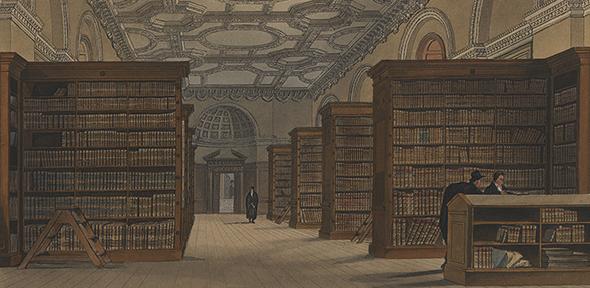
From as early as the middle of the fourteenth century, the University of Cambridge owned and kept in chests in its treasury a small collection of books. However, it was in the second decade of the fifteenth century that the first University Library found its home on the newly built Old Schools site.
By the end of the sixteenth century, the Library had in its possession as many as 600 books. However, like other English libraries, the University Library suffered from the destruction and neglect of the Reformation and the years that followed it. Although a catalogue of the Library drawn up in 1557 lists fewer than 200 volumes, a remarkable number of books and manuscripts from the Library’s earliest years did, in fact, survive.
In 1574, Andrew Perne, Master of Peterhouse, engaged the support of Matthew Parker, Archbishop of Canterbury, and other benefactors including Sir Nicholas Bacon, to restore the Library’s collections. Their generous gifts stimulated other benefactions and by the end of the sixteenth century the Library’s holdings approached 1,000 volumes.
The first half of the seventeenth century again saw a number of important additions to the Library, including a collection of Arabic and other manuscripts presented by the Duchess of Buckingham in 1632, and a collection of Hebrew books purchased in 1647. In that same year, Lambeth Library’s collection of 10,000 volumes was bequeathed to the Library, but returned at the request of the new Archbishop William Juxon following the restoration of the monarchy in 1660.
In its place, the library of Richard Holdsworth, Master of Emmanuel, was adjudged to the university in 1664, containing 10,095 printed volumes and 186 manuscripts, including more than 200 incunabula, an important manuscript of Chaucer and a ninth-century manuscript reputed to contain the oldest written remains of the Welsh language.
The beginning of the eighteenth century saw two events that prompted a turning point in the status of the Library. The first was in 1710, when the University Library was included among the nine privileged libraries of copyright deposit under the first Copyright Act. This was followed in 1715 by King George I’s presentation of the renowned library of John Moore, Bishop of Ely, subsequently known as the Royal Library, which contained some 30,000 volumes and 1,790 manuscripts.
From 1867-1886, the librarianship was held by distinguished collector and scholar, Henry Bradshaw, who established efficient structures and procedures, some of which survive in practice today, and set about restoring to order the Library’s collections of manuscripts and rare books.
Bradshaw and his two successors, Francis Jenkinson (librarian from 1889 to 1923) and Alwyn Faber Scholfield (librarian from 1923 to 1949) transformed the Library into a place where scholarship might be pursued and its needs adequately served. This was achieved through their developments of classification and cataloguing systems and their acquisitions of important book and manuscript collections, including the arrival of the Taylor-Schechter fragments from the Cairo genizah in 1898 and the bequest of the A. W. Young in 1933, which included a copy of the Gutenberg Bible.
Under the librarianship of Scholfield and with the generous aid of the Rockefeller Foundation, the Library was built a new, and considerably larger, home designed by Sir Giles Gilbert Scott, which opened in 1934. A number of major acquisitions in all departments came to the Library during the course of the twentieth century, prompting the need to build an additional closed-stack extension which was taken into use in 1972.
Since the turn of the twenty-first century, as well as continuing to grow its physical collections, the Library has focused on its digital collections through the Legal Deposit Libraries Act which extended legal deposit to include electronic materials in 2003, and the launch of the Cambridge Digital Library in 2010.
Image: Illustration of a room in the old University Library, from Ackermann's History of the University of Cambridge, 1815 (Cam.a.815.4).
